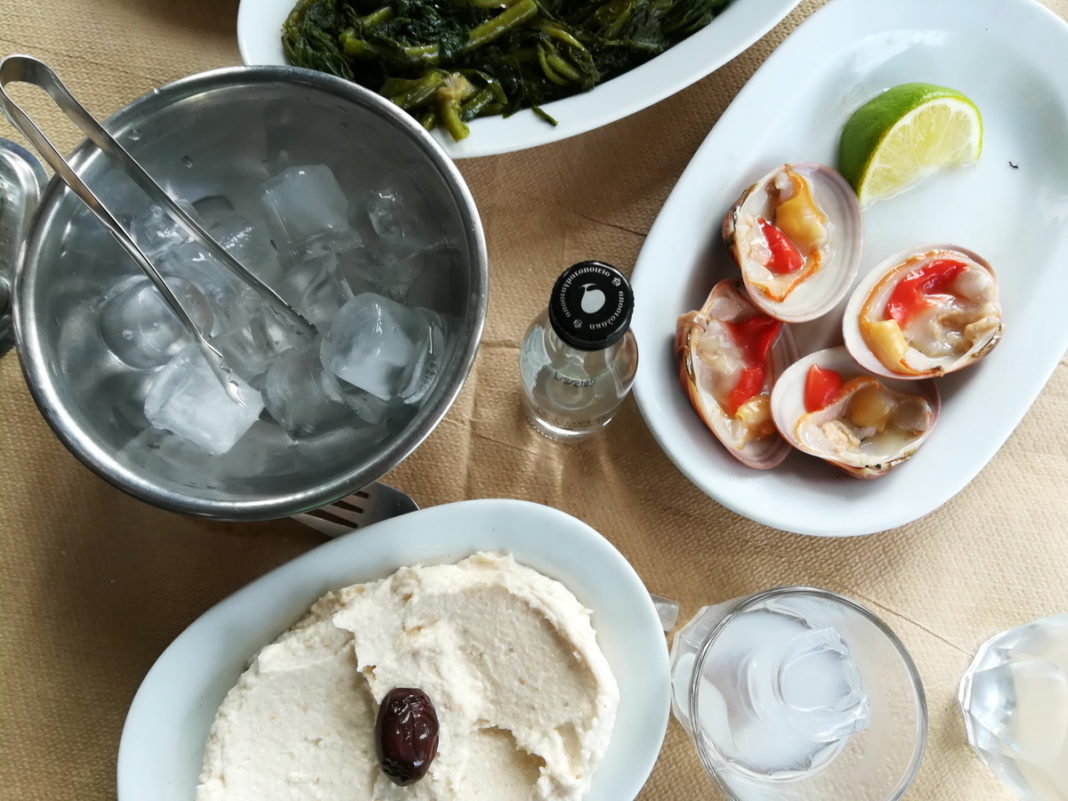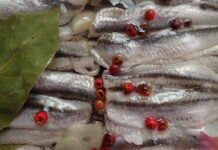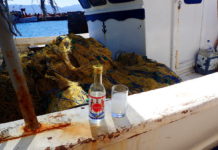Tsipouro is the very essence of the Greek landscape in a glass. A spirit in every sense, this famously strong Greek drink is distilled from the marc or pomace that remains after making wine.
It’s a drink with integrity and personality. With its high alcohol content, some call it Greek moonshine. But that name doesn’t capture the finesse of this traditional Greek spirit. It’s best to think of tsipouro as grappa, Greek style.
Table of Contents
Tsipouro – a Traditional Greek Spirit
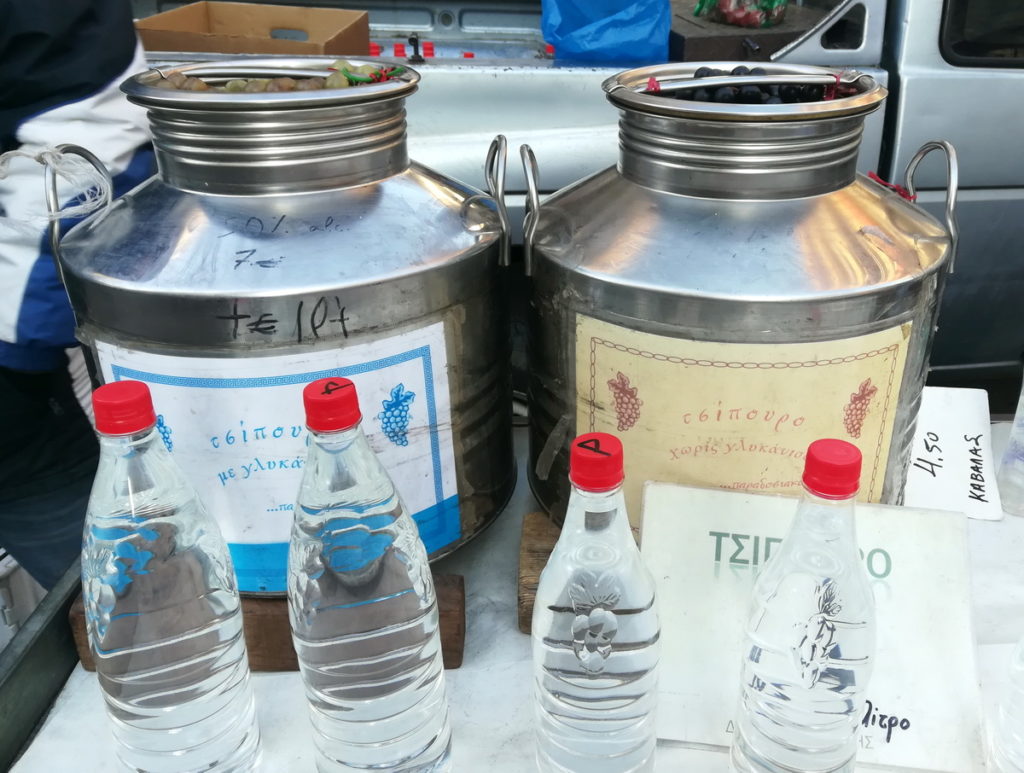
Alcohol is about connection. In Greece and the Mediterranean. even more so. In the case of tsipouro, it’s not only the drink that connects people to each other, but also the process of making it that ties them to the land, to their culture, to the season.
Although ouzo may have the most famous name abroad, and truly is popular in Greece, in many regions throughout Greece it’s actually tsipouro that reigns as Queen of Greek drinks, accompanying tables of meze – tempting small dishes – and evenings of conversation.
There are a couple of reasons for this. The main one has to do with tsipouro’s deeper and more intimate connection to the land. Tsipouro is personal. In Greece, much of it is distilled in small batches, often by someone you know, in a neighborhood still, from grapes grown in their own backyard.
This is the key to the success of tsipouro. Alcohol is about connection, and in Greece and the Mediterranean even more so. In the case of tsipouro, it’s not only the drink that connects people to each other, but also the process of making it that ties them to the land, to their culture, to the season.
Tsipouro is available commercially. But lots of it goes straight from the still, to an old Fanta bottle, to a glass.
What is Tsipouro?
Tsipouro is the distilled spirit of pomace – the leavings of pulp, skins and seeds after the grape harvest has been pressed for wine. The marc is left to ferment, and then is distilled to produce a clear, bracing spirit with an Alcohol by Volume (ABV) of 40 – 45%. It’s essentially the Greek version of Italian grappa or French marc, with the same finesse and authentic character.
And What’s It Like?
Tsipouro has terrior – you taste the environment. Traces of the richness of the soil, even an elusive barnyard earthiness, add depth.
Tsipouro can be surprisingly nuanced for such a powerful drink. This spirit captures the character of the grape so fully that the qualities of an individual grape variety – for instance a moschato or a xynomavro – shine through clearly in a single varietal tsipouro. The drink has terrior – you taste the environment. Traces of the richness of the soil, even an elusive barnyard earthiness, add depth.
The History of Tsipouro
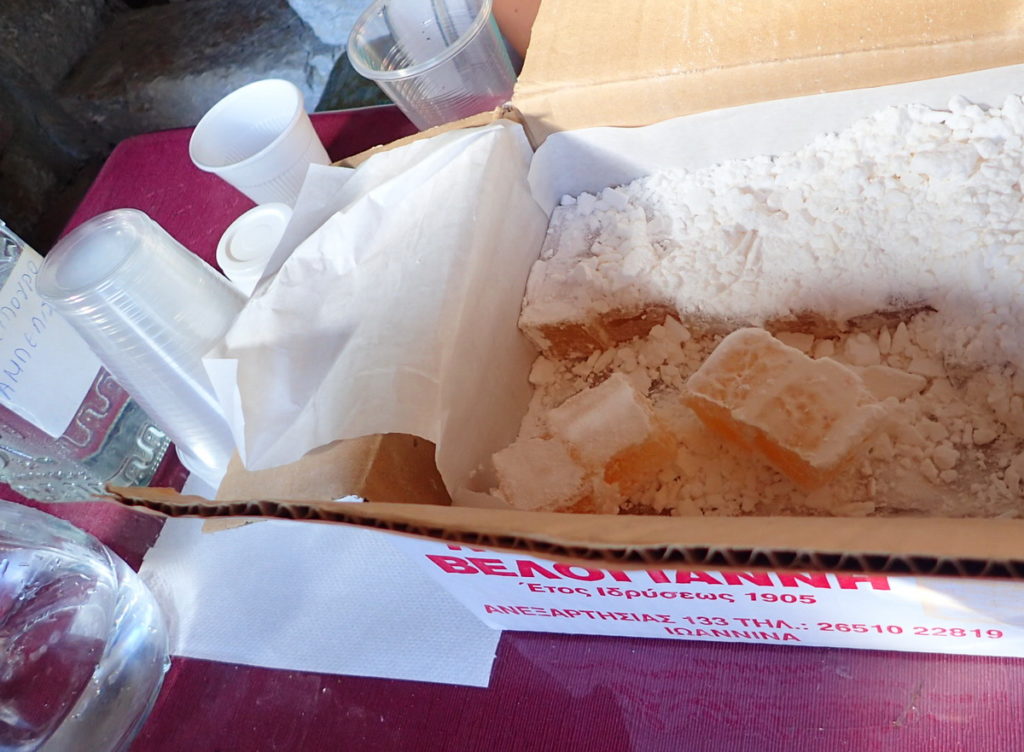
The origins of this most elemental spirit have been lost to time. Sometime after the advent of wine making – which was perhaps around 2000 BC – resourceful vintners found a way to make use of what was left over from the grape pressing.
There are references to distilled alcohols beginning around the 12th century, from both the Arab world and from Italy, and from China perhaps earlier. Around this time, or shortly thereafter, the monks of Mt. Athos began distilling pomace. The resulting spirit became popular during the late Byzantine era.
As the Ottoman Empire took over, the spirit’s popularity spread. Common thought is that the prophet Mohammed had not foreseen the possibility of distilled spirits when forbidding wine. Throughout the former Ottoman Empire, versions of this distilled spirit of grapes thrive. Tsipouro and its cousin from Crete, raki (tsikoudia), are popular throughout Greece. Arak – with its addition of anise – thrives in the Middle East, under the name raki in Turkey. Rakija is popular in Serbia and North Macedonia –rakiya to the Bulgarians, and rakia to the Albanians.
How It’s Made – the Traditional Kazani

Before the first drops of tsipouro begin to flow, the grill is fired up and loaded with souvlaki and chops. Homestyle meze fill the table, along with local wine. The air is tinged with wood smoke, the fumes from the alcohol, the rich aroma of grapes mingling with the scent of charring meat.
Starting shortly after the grape harvest, fires start to blaze under copper stills all over the wine-growing regions of Greece. This is the season of the “Kazani.” A Kazani is the name both for the copper still used in the production of tsipouro, and for a unique and festive event. A Kazani is a distilling party, and in the distilling season – directly after the grape harvesting season – there are many of them.
Small stills have operated by special license since the days of the Ottoman empire. These licenses have been handed down through the generations. The tax authorities break a seal on the still on a certain day. From that moment on, the fires burn around the clock until the still is sealed again at the close of the season, in order to produce as much spirit as possible.
The license holders of these copper stills distill their own grapes, and also rent out the still to others in the community in time slots. Many different parties come in to use the still, one after the other all throughout the day and the night. They bring their own fermented pomace, plus snacks and meats to enjoy with their friends while the pomace distills. The Kazani – a favorite fall ritual – is about to begin.
Before the first drops of tsipouro begin to flow, the grill is fired up and loaded with souvlaki and chops. Homestyle meze fill the table, along with local wine. The air is tinged with wood smoke, the fumes from the alcohol, the rich aroma of grapes mingling with the scent of charring meat.
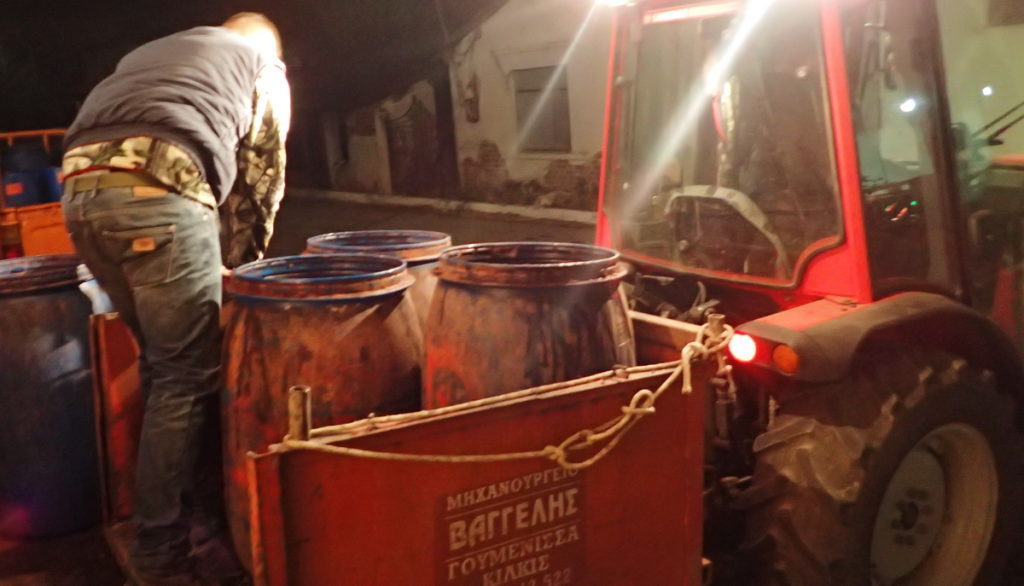
Vats of pomace for tsipouro arriving by tractor 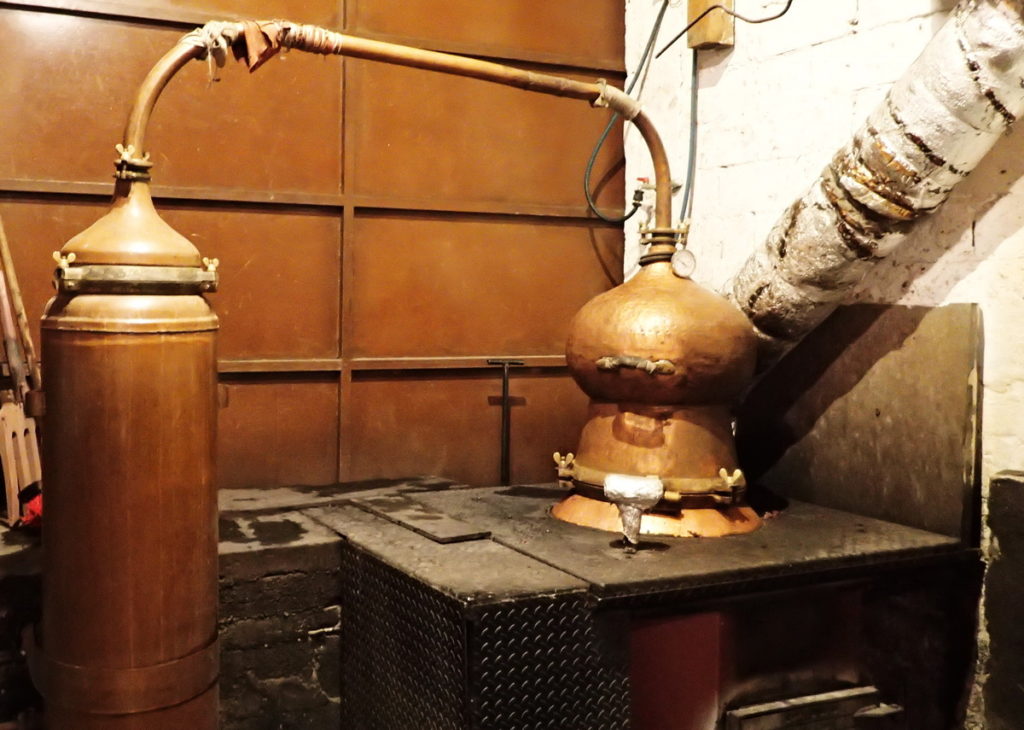
A copper still at a Kazani in Goumenissa 
As the tsipouro distills, souvlakia char on the grill. 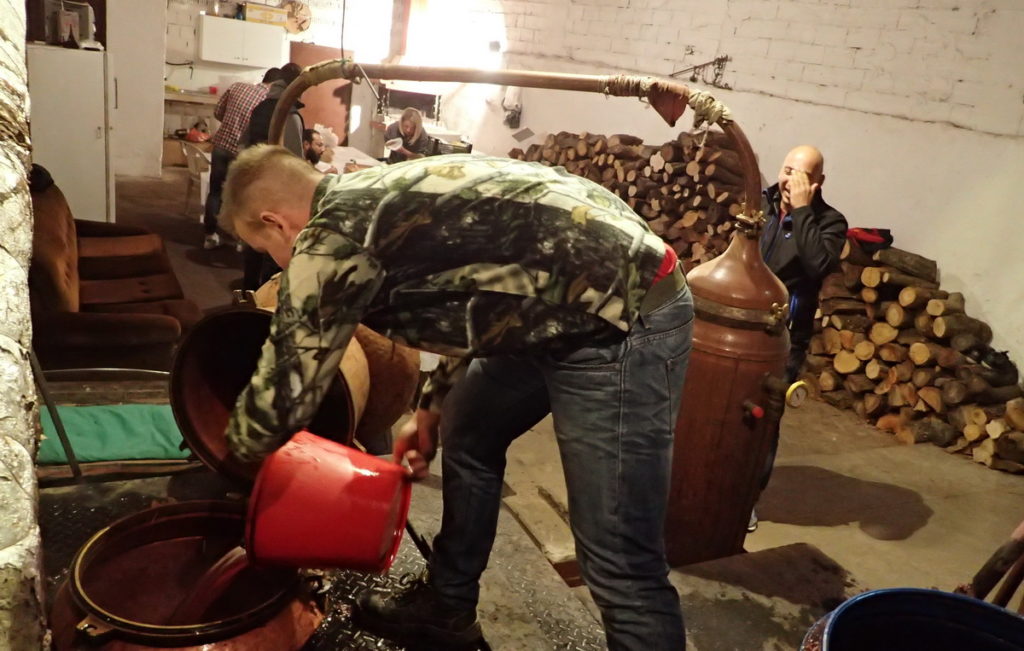
Filling the still with buckets of fermented grape mash 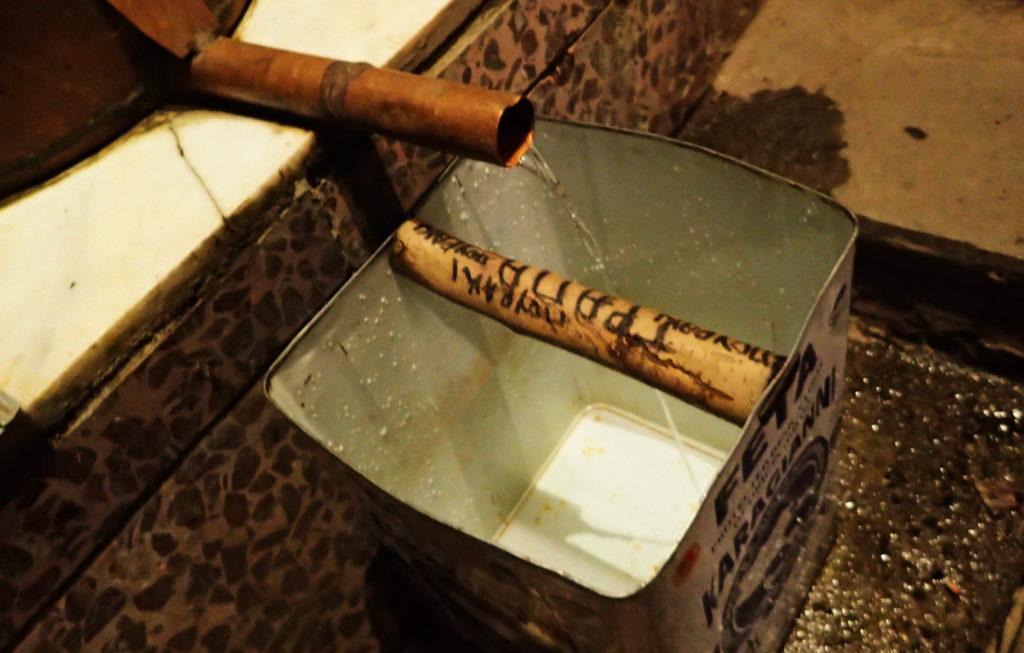
Tsipouro flows from the still into an old feta tin. The handle is marked “Grapa.”
The Distilling Process
Plastic vats of pomace arrive via tractor at the still. The copper still gets a quick rinse to wash out the previous batch. Then a fresh batch of pomace goes in. The fire blazes continuously. Wood is stacked high along the wall.
As the grape pomace comes to a brisk boil, the scent of grapes starts to fill the air. Then the condensation collects in copper coils. These cool it as it flows into a container – often an old feta cheese tin.
The first spirit to flow – clear like water – is the strongest in alcohol content. The distiller sets it aside. The heart – the spirit from the middle of the distilling process – makes the finest and smoothest drinking. As it gets to the tail, the alcohol content diminishes. The spirit can develop a “cooked” taste after a long boil – just like a soup. There’s an alcohol meter to test the ABV of each container. The distiller can control the alcohol content by blending some of the bold initial distillate with the heart.
How much pomace do you need for a kilo of tsipouro? 120 kilos of grape skins and pulp yields roughly 20 kilos – the ratio varies from about 5:1 to 7:1.
Tsipouro of Tyrnavo and PDO
The town of Tyrnavos in Thessaly is in the heart of an agriculturally rich region. Tyrnavos is famous for its PGI (Protected Geographic Origin) wines of the Black Muscat grape (Muscat of Hamburg).
But for many, Tyrnavos is synonymous with quality tsipouro – it’s the only Greek city to have a PGI designation for tsipouro from the European Union. Those same aromatic Black Muscat grapes make the tsipouro Tirnavou unusually velvety and complex.
Tsipouro plays a prominent role in the culture of Tyrnavos, specifically in their famous “Apokreas” – the carnival celebrations preceding Lent. Tyrnavos’ carnival culminates in the “Bourani” – an unabashedly baudy and phallus-forward Dionysian celebration of fertility of ancient origins. The Orthodox church’s attempts to tone down the ecstatic pagan festivities have not met with compliance.
What Does Tsipouro Taste Like?
It depends on whether it’s “with” or “without” – meaning with or without anise.
When you order a carafe or a bottle of tsipouro, the question is “με ή χωρίς” (‘me i horis‘) – “with, or without?”. (‘me‘ is with a short ‘e‘. The ‘i‘ for ‘or’ is pronounced like the letter ‘e‘. ‘Horis‘ is with a long ‘i‘ and the accent on the second syllable).
Much tsipouro was, and still is, distilled with anise seeds and other aromatics for a spirit like ouzo, but with a stronger, lustier personality. Like ouzo, it will turn white and cloudy in the glass with the addition of water. This is because the anise oils are not water soluble.
Many prefer their tsipouro without anise or any other aromatics, in order to let the character of the grape shine cleanly through. Plain, it’s similar to Italian grappa and French Marc. The version without anise is gaining in popularity.
What’s the Difference between Tsipouro and Ouzo? Ouzo is always with anise, while tsipouro can also plain. The main difference between tsipouro with anise and ouzo is that ouzo is a more delicate drink, with a neutral-tasting alcohol base, even if from grapes. Tsipouro however keeps all of the complexity and character of the grape intact, adding the aromatics to it. It’s both stronger in taste, and stronger in alcohol content. Ouzo has a minimum ABV (alcohol by volume) of 37.5%, while tsipouro has an ABV of 40% – 45%. Many associate ouzo with the summertime, while tsipouro is very much a year-round drink.
How To Drink It
Many take tsipouro neat, in small sips – particularly when it’s without anise.
Alternatively, it’s very refreshing over ice, often with a little water. This releases volatile aroma molecules into the headspace, letting the full spectrum of aromas unfold on the palate. This is also a popular way to enjoy tsipouro with anise, much like how to drink ouzo.
How To Serve Tsipouro
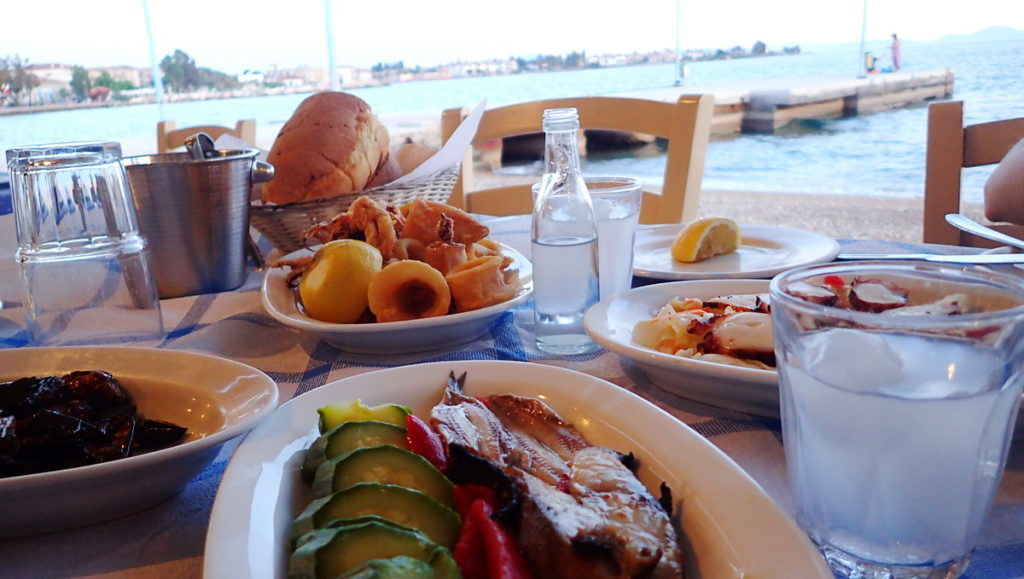
Tsipouro, like all Greek drinks, is made to be enjoyed with food, and more importantly with company. With its bold flavor, it stands up to equally bold meze – the small dishes served with Greek spirits or wine. The meze are often salty, zesty, or piquant.
Ouzo usually accompanies mezedes from the sea. But tsipouro is also excellent with zesty meat dishes, or spicy cheese dishes, like a bougiourdi. This is especially true when it’s without anise.
This combination of zesty meze, tsipouro, and conversation is so popular that it has its own type of restaurant. The Tsipouradiko is an essential Greek institution.
The Tsipouradiko

The tsipouradiko, like its cousin the ouzerie, is much more than a place to eat – it’s a cultural institution. One Greek city – not Tyrnavos but rather Volos – is particularly famous for its tsipouradiko culture.
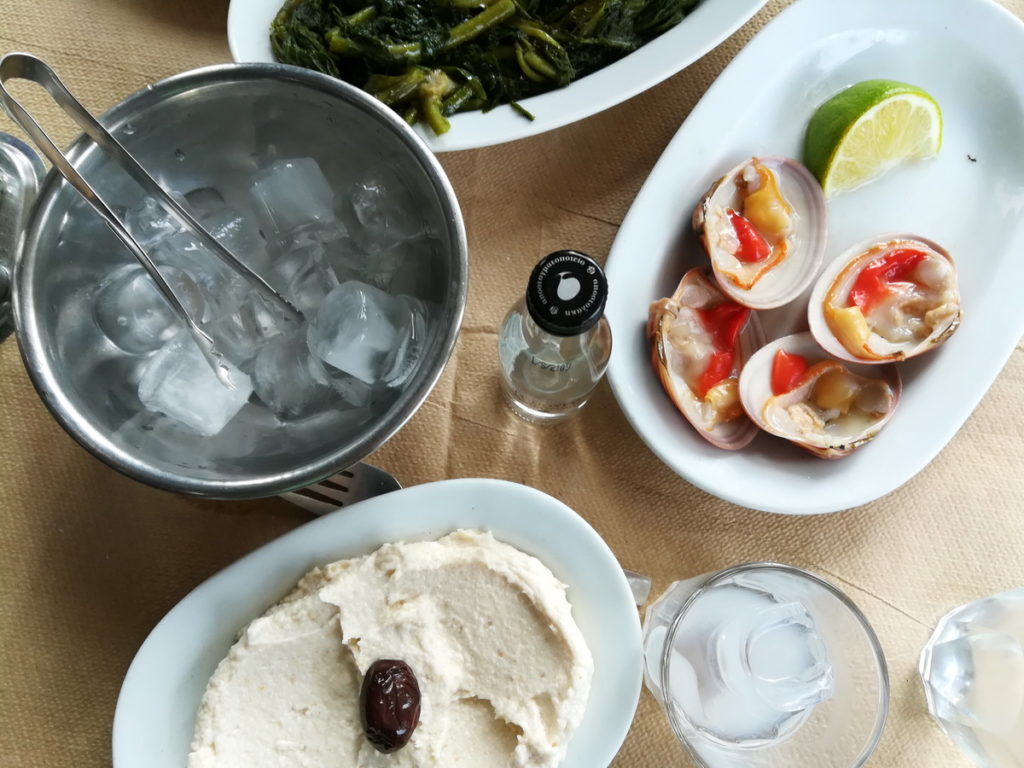
Sweet and succulent fresh clams and taramosalata with tsipouro at Demiris, Volos 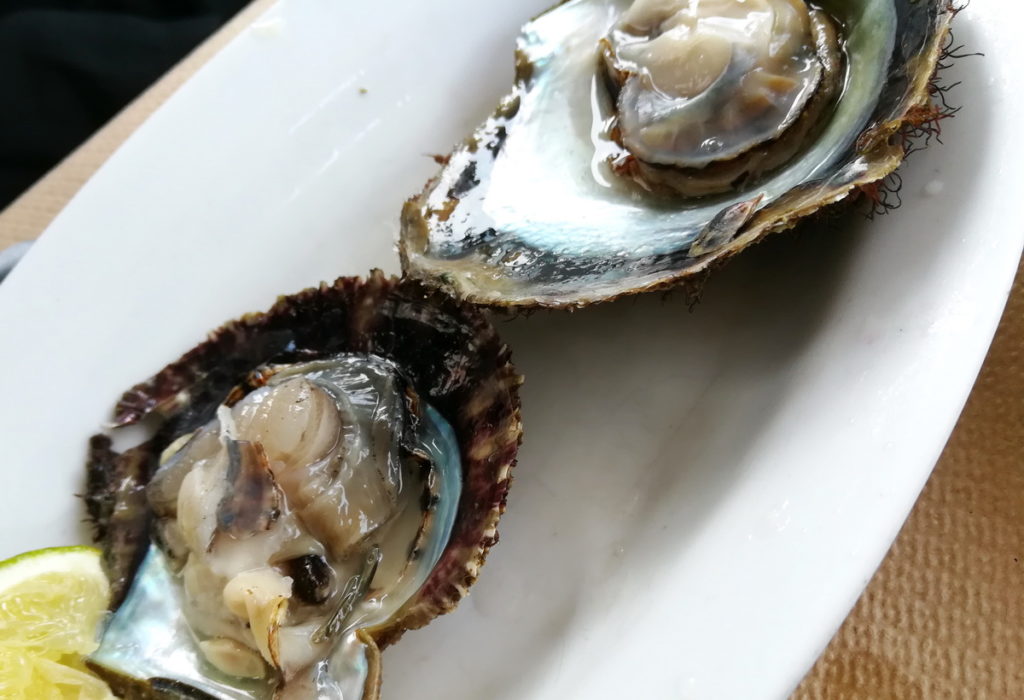
Fresh shellfish stars alongside tsipouro at the legendary Tsipouradiko “Demiris” in Volos
The tsipouradika of Volos serve individual small bottles of 25 ml. Locals line up the tiny empty bottles in the middle of the table, the better to keep track. Each round comes with mezedes – small dishes – that the chef selects to go best with the drink. It’s a curated drinking experience that maximizes the harmony of food and drink. The succession of fresh bottles and dishes sets a measured pace for an evening of great conversation.
The tsipouradiko – like its cousin the ouzerie – is an essential cultural institution
Elsewhere throughout Greece, you’ll usually order tsipouro by the carafe or bottle, and choose a selection of meze. A bottle is usually 200 ml – just right for two people to enjoy very slowly, and a nice start for a party of four.
Aged Tsipouro
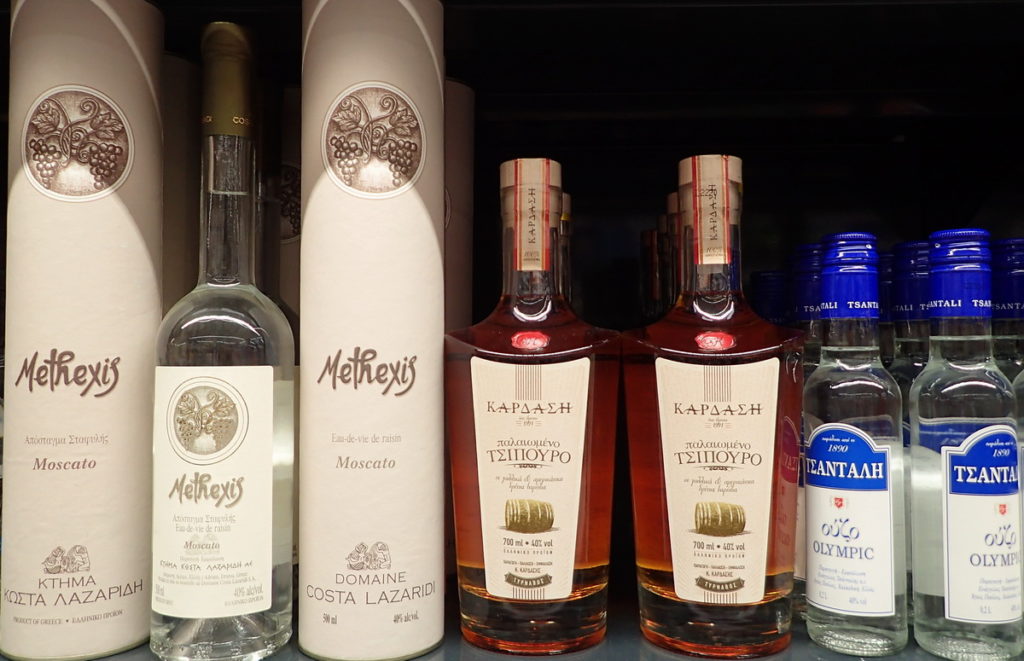
Aged tsipouro is a relatively new drink in Greece. As tsipouro without anise ages in wooden barrels, the wood itself and the previous contents of the barrel add their own character to the spirit over time – much like whisky. Also like whiskey, it takes on a hue – from pale gold to rich amber. Some in fact refer to them as the “Greek Malt.” They vary in aroma and color, depending on the barrel used and the length of the aging. They also vary greatly in price – a fine bottle can reach close to €100. Many good selections are in the €20 to €35 range.
How Much does Tsipouro Cost?
Tsipouro is an agricultural product with working-class roots. Like grappa and mark, in both character and flavor it’s the drink of choice of those close to the land – always a compelling endorsement.
It’s an inexpensive drink. 200 ml bottles start at under €4 in stores, and at about €7 in a tsipouradiko. The price of a 700 ml bottle begins at about €12.
A lot of tsipouro is sold straight from the barrel. You’ll find it at small neighborhood grocers and at the weekly farmers markets. You can also order it by the carafe at tsipouradika and taveras, along with commercially bottled options.
Tsipouro’s low price does not at all indicate low quality. This is an agricultural product with working-class roots. Like grappa and mark, in both character and flavor it’s the drink of choice of those close to the land – always a compelling endorsement.
How to Buy Tsipouro – Brand Names to Look for
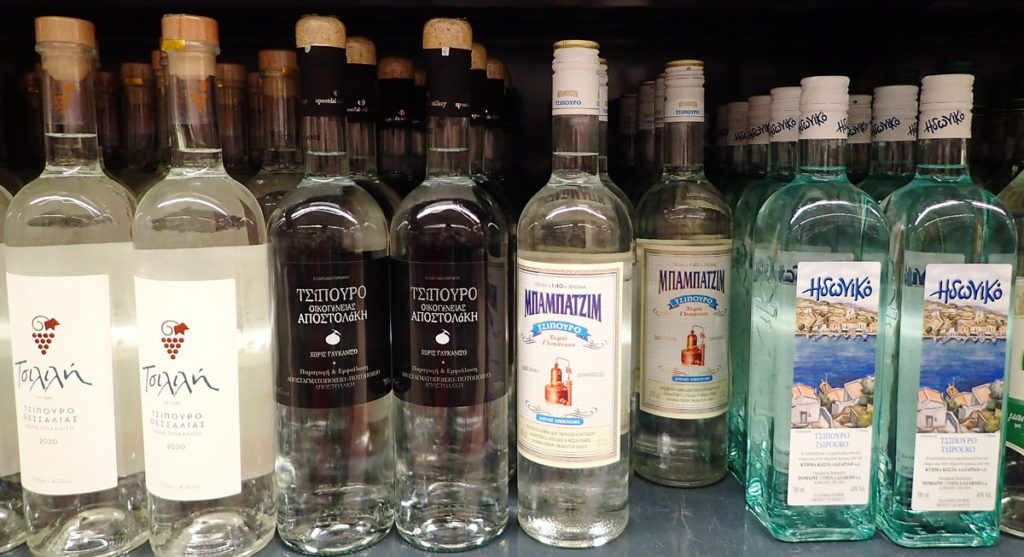
If you’re in Greece, by all means try the house distillate – with anise or without – at a tsipouradiko. Or pick up some at a small grocery store, where they’ll fill you a small plastic bottle from a tap.
For bottled brands from Tyrnavos, try the Trynavos Cooperative Winery and Distillery as well as the Tyrnavos distillers Agrafiotis, Kardasis, Katsaros, Papras, Vasdavanos, and Vrissas. Other popular brands include Dekaraki of Evia, Tsilili tsipouro of Thessaly with a PDI, from Macedonia Idoniko and Babazim, and Glivanos of Epirus.
Where to Buy Tsipouro in the USA and in the UK? Many of the best brands are available from Greece and Grapes. They can ship to both the UK and the USA.
Tsipouro Cocktails – A Traditional Spirit in the Contemporary World
Tsipouro has always been a traditional drink, but for decades it was definitely not a fashionable one. This is changing, as a new generation of Greeks comes to celebrate the quality and the purity of Greece’s indigenous products. Tsipouro cocktails – often blending the spirit with local herbs and other ingredients – express a uniquely Greek identity.
More about Tsipouro-
Is tsipouro the same as ouzo? – Tsipouro, whether with or without anise, is a gutsier, earthier drink than ouzo. It has a higher alcohol content, and can also be had without anise. Ouzo is always with anise, and has a neutral alcohol base.
Is it the same as grappa? – Yes and no. Tsipouro without anise and other aromatics is like Italian grappa.
Is it the same as Turkish raki? – Again, yes and no. Turkish raki is usually flavored with anise. Tsipouro with anise – rather than plain – is a similar drink.
What is tsipouro made from? – Always from grapes, from the leavings after the wine pressing, or, in some cases from the mashed, whole grape. Some distillers use a single grape variety to highlight its characteristics.
How to pronounce tsipouro – “Tsee – pour – oh” with the accent on the first syllable.
Does tsipouro have carbs? – Like other sugar-free spirits, it’s carb free and keto-friendly, as are many of the traditional meze that go with it.
Is tsipouro good for you? – This is a strong spirit. But it’s also a very sociable one, easy to enjoy in moderation with good food, and good friends. For more on alcohol and the Mediterranean lifestyle, try Mastering the Art of Greek Drinking.

